High Street
|

Portobello High Street from the
railway bridge, looking
west towards Wolverhampton in 1959. |
The bill postings extended from the bridge to the
first house. The first twelve houses were built to house railway
workers from the Grand Junction Railway, which opened in 1837. The
sixth house is a greengrocer's, owned by Mrs. Bratt and the twelfth
house is the baker's shop, owned by Mr. and Mrs. Hancocks. Next
door, painted white is Mr. and Mrs. Roberts' butchers shop. Next is
the Bird In Hand public house, run by Mr. and Mrs. Jefcott. |
| The shop on the corner is Mr. and Mrs. Shevin's
general stores and greengrocers and next door is the Cock Inn,
that was owned by Mr. and Mrs. Davies. Behind it is the Cock Inn
yard with its entrance to the left of the pub. Next on the left
is the Portobello Post Office run by Mr. and Mrs. Weaver. A new
post office was later built across the road and the Weavers took
it over. |
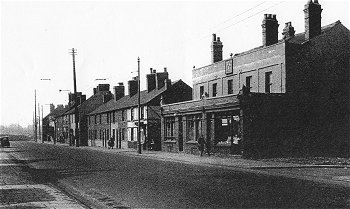
High Street Portobello, 1959. On the right
is Bennett St. |
| The old post office then became the home of Mr.
and Mrs. Pritchard and finally was a grocer's shop run by Mr.
and Mrs. T. Adams. At the end of the row of buildings is the
entrance to Stone Street and beyond is the Malt Shovel pub. In
the far distance the entrance to Primrose Street can be seen
with the New Inns on the corner. |
|
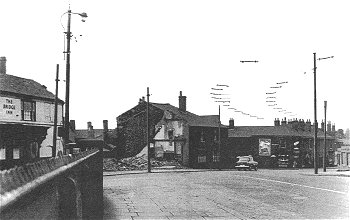
Another view of High Street from the
railway bridge. |
On the left is the Bridge Inn pub and to its right
on the corner of Brickkiln Street is the Methodist Chapel. To
the right of Brickkiln Street is Falon's General Stores and to
its right is Baker's Fish and Chip Shop.
The three demolished houses next to the Bird In Hand were
occupied by the Gough family, the Haynes family and Mrs. Payton,
who was known locally as "Cockanary". |
| Haynes' house was also used as the headquarters
of the Liberal Party during local and national elections. |
| On the left is the Wesley Chapel that was built in
1868. On its right is Brickkiln Street and on the corner is E.
Williams' grocers shop. |
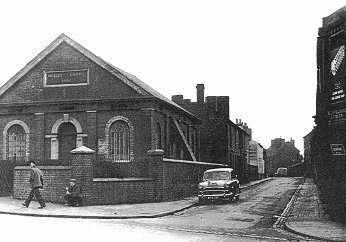
The Methodist Chapel. |

A similar view from the railway bridge in
1928 with what
appears to be an A.J.S. combination in the foreground. |
On the left is the Bridge Inn and to its right is
the Gough family house, the Haynes' house, the Payton's house
and Jones Sweet Shop.
The tram lines can be seen behind the motorcycle.
|
|
On the left is Jones Sweet Shop and to its right
is the entrance to the Methodist Chapel. Behind the chapel is
Brickkiln Street and on the far corner is Falon's General
Stores.
|

Another view from the 1950s.
|
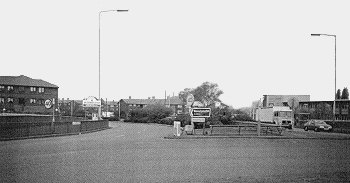
The same view in the 1990s.
|
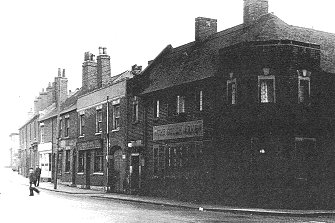
High Street looking eastwards.
|
On the corner is the Gough Arms and in the
distance is the Bridge Inn with the railway bridge beyond. |
| This view of the High Street is from 1959 and
shows some of the 1930s houses that changed the look of the
area. The church is Saint Alban's, known locally as the
"Mission". On the left is the Cock Inn. |
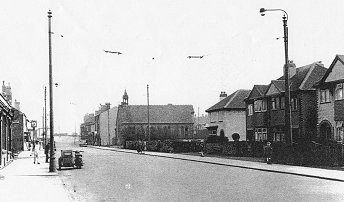
Another view looking east along High
Street. |
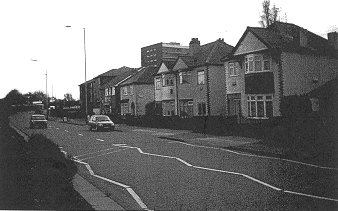
The same view in 1995.
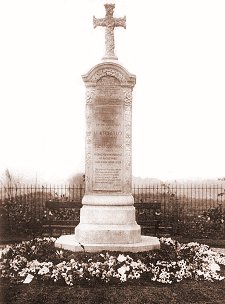
Portobello war memorial on 22nd of
July 1920. |
To the east of the railway bridge by the side of
the railway is the Portobello war memorial. It was erected by
the local inhabitants and dedicated to the brave men of
Portobello who fought in the Great war and in grateful
remembrance of those who laid down their lives. |
|
Also on the east end of the railway bridge is Portobello Council
School, which is now the community centre.
|

Portobello School in 1920.
|
|
 |
A class of infants from the
school in the early 1920s. The teacher on the left is
Mrs. A. Tindsley. |

|
|

|
Return
to the
previous page |
|
Proceed to the
next page |
|